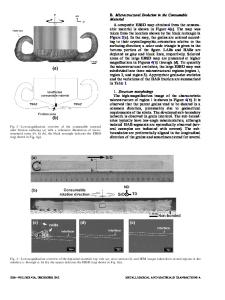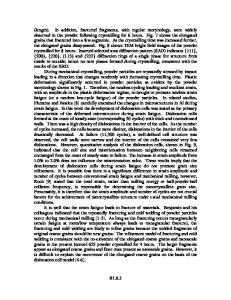Microstructural Evolution in Niobium-Based Alloys
- PDF / 1,069,923 Bytes
- 13 Pages / 593.972 x 792 pts Page_size
- 0 Downloads / 382 Views
TRODUCTION
IN order to improve the high-temperature strength and oxidation properties of Nb-based alloys, the concept of an in-situ composite was introduced where a hard silicide phase forms in the softer matrix phase and remains stable at elevated temperatures and provides adequate strength to the material at those temperatures.[1] In addition to Si as a major alloying element, other alloying elements such as Ti, Al, and Cr,[2–4] are added to improve high-temperature oxidation properties of the matrix phase. The results of previous studies[5] have shown that, though, the addition of Ti leads to appreciable improvement in the oxidation resistance and intrinsic ductility of these alloys, it also reduces the liquidus point and the high-temperature strength of the alloys. Therefore, to counteract the latter effects of Ti, elements such as Zr and Hf were added, because these provide strong solid solution strengthening to the Nb-based solid solution phase.[4,5] Both Al and Cr have also been reported to improve the high-temperature oxidation properties of the Nb alloys. However, high concentration (>10 pct) of these may lead to the formation of the aluminides and Laves phase, respectively. Because all the elements have different solubility in the b phase and also due to the synergistic effects of simultaneous presence of these elements, variations in the concentration of added elements can cause various precipitation reactions in the b phase. R. TEWARI, Scientific Officer ‘G’, and G.K. DEY, Head, are with the Materials Science Division, Bhabha Atomic Research Centre, Mumbai 400 085, India. Contact e-mail: raghvendra.tewari@gmail. com H. SONG, PhD Student and V.K. VASUDEVAN, Professor, are with the Department of Chemical and Materials Engineering, University of Cincinnati, OH-45219. A. CHATTERJEE, Senior Manager, is with Materials and Processing, Rolls Royce, Indianapolis, IN-46206. This article is based on a presentation given in the symposium entitled ‘‘Materials Behavior: Far from Equilibrium’’ as part of the Golden Jubilee Celebration of Bhabha Atomic Research Centre, which occurred December 15–16, 2006 in Mumbai, India. Article published online April 16, 2008 1506—VOLUME 39A, JULY 2008
The aim of the present article is to study the effect of various alloying elements in the formation of phases, in their stabilities at the proposed operating temperature, and the various morphologies of all phases evolved during aging at different temperatures. The effect of these changes on the mechanical properties of alloys has also been studied. For this purpose, four series of alloys were prepared, each with different alloying elements in varying concentration, but keeping the base composition nearly the same in all alloys.
II.
EXPERIMENTAL
A series of alloys in the form of ingots, buttons, or cigars (listed in Table I; in this article, the compositions are given in atomic percent unless otherwise specified) were prepared by the Flow Serve Company (Dayton, OH) by vacuum induction skull melting of commercial purity elements. After remeltin
Data Loading...










